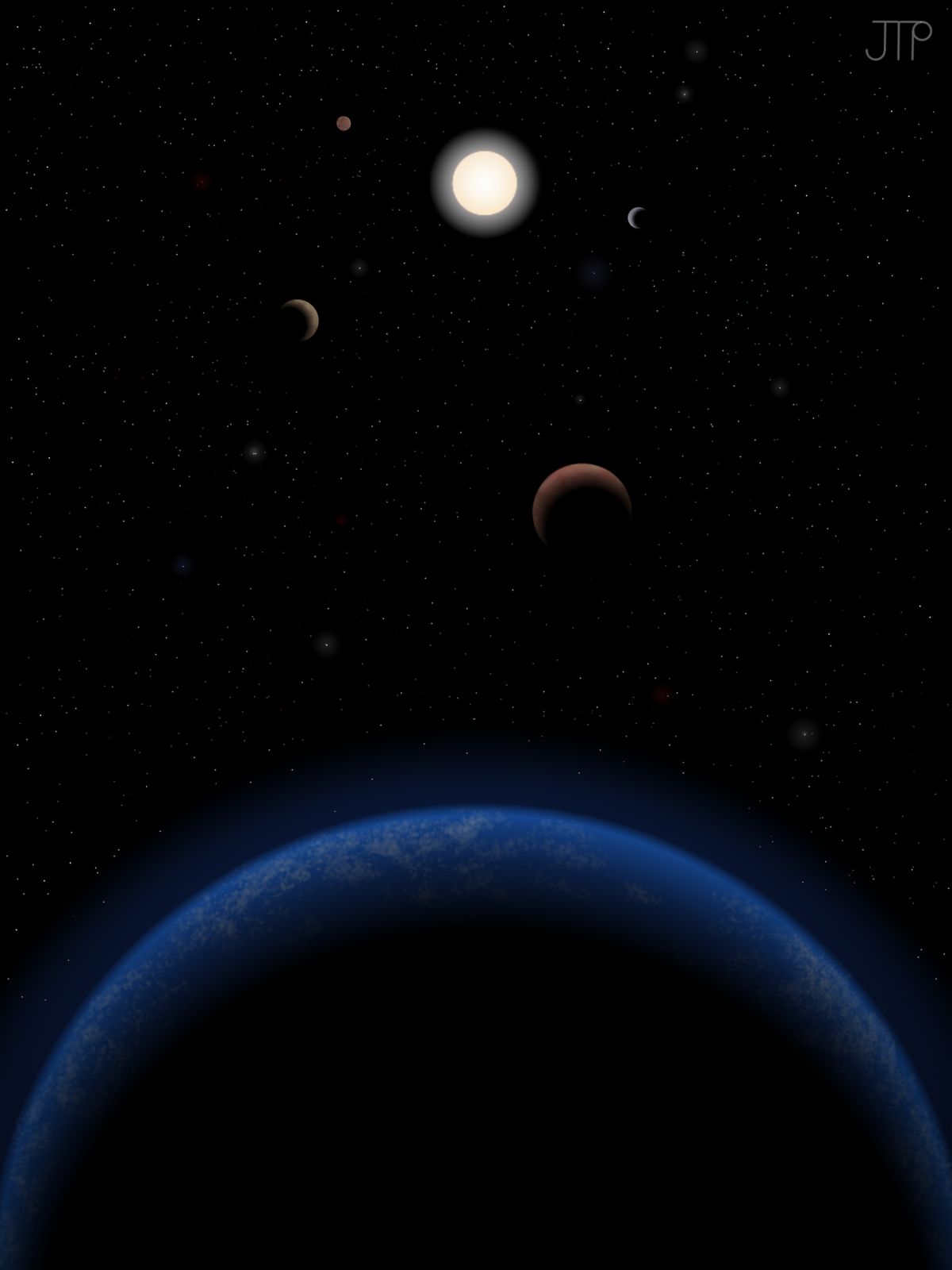
A sun-like star in our solar system's backyard may host five planets, including one perhaps capable of supporting life as we know it, a new study reports.
Astronomers have detected five possible alien planets circling the star Tau Ceti, which is less than 12 light-years from Earth — a mere stone's throw in the cosmic scheme of things. One of the newfound worlds appears to orbit in Tau Ceti's habitable zone, a range of distances from a star where liquid water can exist on a planet's surface.
With a minimum mass just 4.3 times that of Earth, this potential planet would be the smallest yet found in the habitable zone of a sun-like star if it's confirmed, researchers said.
"This discovery is in keeping with our emerging view that virtually every star has planets, and that the galaxy must have many such potentially habitable Earth-sized planets," study co-author Steve Vogt, of the University of California, Santa Cruz, said in a statement. "They are everywhere, even right next door." [Gallery: 7 Potentially Habitable Exoplanets]
The five planet candidates are all relatively small, with minimum masses ranging from 2 to 6.6 times that of Earth. The possibly habitable world, which completes one lap around Tau Ceti every 168 days, is unlikely to be a rocky planet like Earth, researchers said.
"It is impossible to tell the composition, but I do not consider this particular planet to be very likely to have a rocky surface," lead author Mikko Tuomi, of the University of Hertfordshire in England, told SPACE.com via email. "It might be a 'water world,' but at the moment it's anybody's guess."
Spotting signals in the noise
Sign up for the Live Science daily newsletter now
Get the world’s most fascinating discoveries delivered straight to your inbox.
Tau Ceti is slightly smaller and less luminous than our sun. It lies 11.9 light-years away in the constellation Cetus (the Whale) and is visible with the naked eye in the night sky. Because of its proximity and sun-like nature, Tau Ceti has featured prominently in science fiction over the years.
Astronomers have searched for exoplanets around Tau Ceti before and turned up nothing. But in the new study, researchers were able to pull five possible planetary signals out from under a mountain of noise.
Tuomi and his team re-analyzed 6,000 observations of Tau Ceti made by three different spectrographs, instruments that allow researchers to detect the tiny gravitational wobbles orbiting planets induce in their parent stars.
The three instruments are the High Accuracy Radial velocity Planet Searcher (HARPS), on the European Southern Observatory's 3.6-meter telescope in La Silla, Chile; the University College London Echelle Spectrograph (UCLES) on the Anglo-Australian Telescope in Siding Spring, Australia; and the High Resolution Echelle Spectrometer, or HIRES, on the 10-meter Keck telescope atop Mauna Kea in Hawaii.
Using new analysis and modeling techniques, the team spotted the five faint signals, successfully separating them from noise caused by stellar activity and other factors.
"We pioneered new data modeling techniques by adding artificial signals to the data and testing our recovery of the signals with a variety of different approaches," Tuomi said in statement. "This significantly improved our noise modeling techniques and increased our ability to find low-mass planets."
The new analysis methods should aid the search for small planets, allowing more and more of them to be spotted throughout the galaxy, researchers said. [A Galaxy Full of Alien Planets (Infographic)]
A nearby planetary system?
The five planets remain candidates at this point and will not become official discoveries until they're confirmed by further analysis or observations. And that's not a sure thing, researchers said.
"I am very confident that the three shortest periodicities are really there, but I cannot be that sure whether they are of planetary origin or some artifacts of insufficient noise modelling or stellar activity and/or magnetic cycles at this stage," Tuomi said, referring to the potential planets with orbital periods of 14, 35 and 94 days (compared to 168 days for the habitable zone candidate and 640 days for the most distantly orbiting world).
"The situation is even worse for the possible habitable zone candidate, because the very existence of that signal is uncertain, yet according to our detection criteria the signal is there and we cannot rule out the possibility that it indeed is of planetary origin," he added. "But we don't know what else it could be, either."
If the Tau Ceti planets do indeed exist, their proximity would make them prime targets for future instruments to study, researchers said.
"Tau Ceti is one of our nearest cosmic neighbors and so bright that we may be able to study the atmospheres of these planets in the not-too-distant future," James Jenkins, of the Universidad de Chile and the University of Hertfordshire, said in a statement. "Planetary systems found around nearby stars close to our sun indicate that these systems are common in our Milky Way galaxy."
If confirmed, the Tau Ceti planets would not be the closest exoplanets to Earth. That title still goes to Alpha Centauri Bb, a roasting-hot, rocky world recently spotted just 4.3 light-years away, in the closest star system to our own.
The new study has been accepted for publication in the journal Astronomy & Astrophysics.
This story was provided by SPACE.com, a sister site to Live Science. Follow SPACE.com senior writer Mike Wall on Twitter @michaeldwallor SPACE.com @Spacedotcom. We're also on Facebookand Google+.













